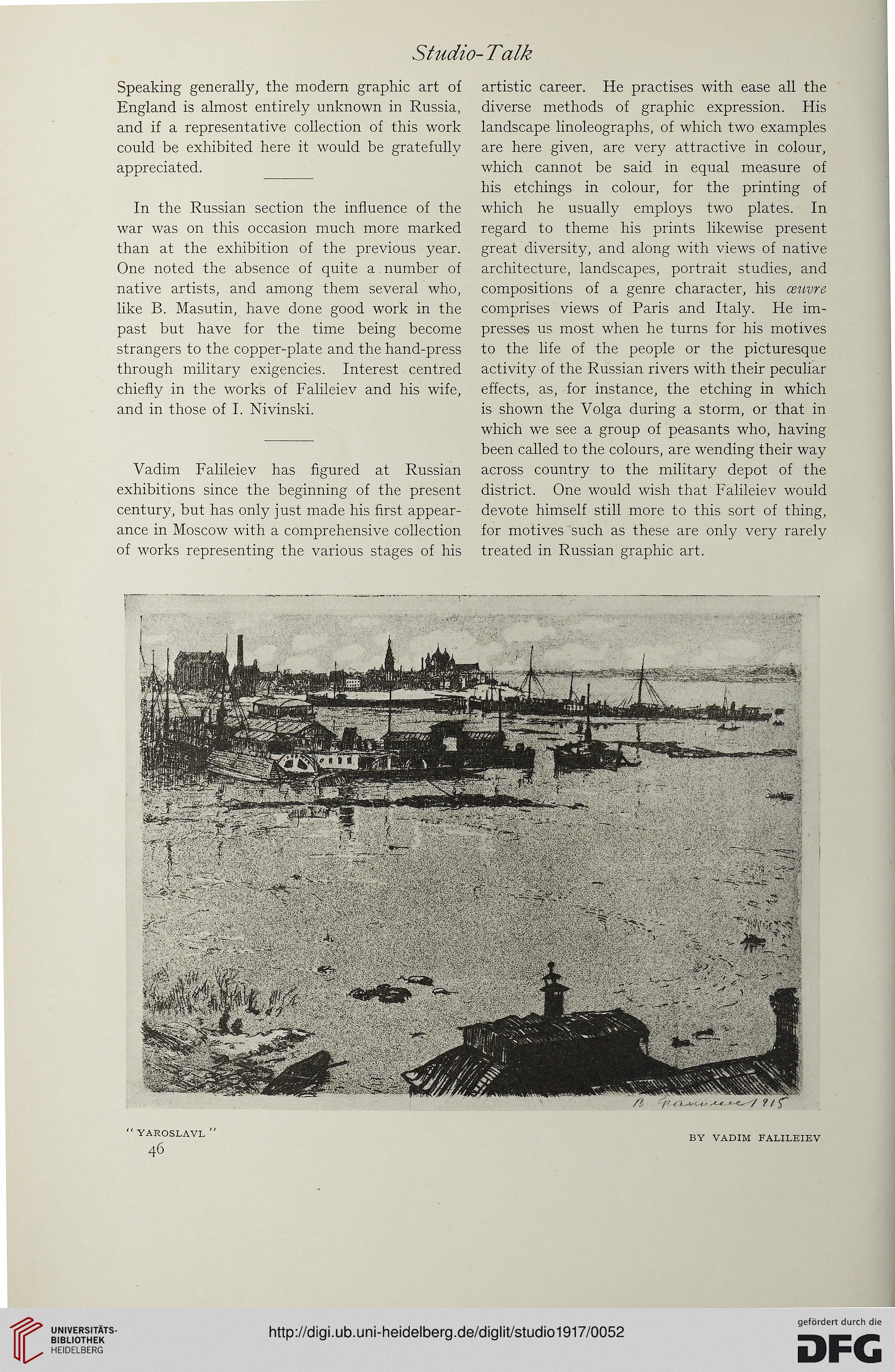Studio-Talk
Speaking generally, the modern graphic art of
England is almost entirely unknown in Russia,
and if a representative collection of this work
could be exhibited here it would be gratefully
appreciated.
In the Russian section the influence of the
war was on this occasion much more marked
than at the exhibition of the previous year.
One noted the absence of quite a number of
native artists, and among them several who,
like B. Masutin, have done good work in the
past but have for the time being become
strangers to the copper-plate and the hand-press
through military exigencies. Interest centred
chiefly in the works of Falileiev and his wife,
and in those of I. Nivinski.
Vadim Falileiev has figured at Russian
exhibitions since the beginning of the present
century, but has only just made his first appear-
ance in Moscow with a comprehensive collection
of works representing the various stages of his
artistic career. He practises with ease all the
diverse methods of graphic expression. His
landscape linoleographs, of which two examples
are here given, are very attractive in colour,
which cannot be said in equal measure of
his etchings in colour, for the printing of
which he usually employs two plates. In
regard to theme his prints likewise present
great diversity, and along with views of native
architecture, landscapes, portrait studies, and
compositions of a genre character, his oeuvre
comprises views of Paris and Italy. He im-
presses us most when he turns for his motives
to the life of the people or the picturesque
activity of the Russian rivers with their peculiar
effects, as, for instance, the etching in which
is shown the Volga during a storm, or that in
which we see a group of peasants who, having
been called to the colours, are wending their way
across country to the military depot of the
district. One would wish that Falileiev would
devote himself still more to this sort of thing,
for motives such as these are only very rarely
treated in Russian graphic art.
v.y
-■‘- V V.
' ' V' I
, &
" YAROSLAVL ”
fib
BY VADIM FALILEIEV
Speaking generally, the modern graphic art of
England is almost entirely unknown in Russia,
and if a representative collection of this work
could be exhibited here it would be gratefully
appreciated.
In the Russian section the influence of the
war was on this occasion much more marked
than at the exhibition of the previous year.
One noted the absence of quite a number of
native artists, and among them several who,
like B. Masutin, have done good work in the
past but have for the time being become
strangers to the copper-plate and the hand-press
through military exigencies. Interest centred
chiefly in the works of Falileiev and his wife,
and in those of I. Nivinski.
Vadim Falileiev has figured at Russian
exhibitions since the beginning of the present
century, but has only just made his first appear-
ance in Moscow with a comprehensive collection
of works representing the various stages of his
artistic career. He practises with ease all the
diverse methods of graphic expression. His
landscape linoleographs, of which two examples
are here given, are very attractive in colour,
which cannot be said in equal measure of
his etchings in colour, for the printing of
which he usually employs two plates. In
regard to theme his prints likewise present
great diversity, and along with views of native
architecture, landscapes, portrait studies, and
compositions of a genre character, his oeuvre
comprises views of Paris and Italy. He im-
presses us most when he turns for his motives
to the life of the people or the picturesque
activity of the Russian rivers with their peculiar
effects, as, for instance, the etching in which
is shown the Volga during a storm, or that in
which we see a group of peasants who, having
been called to the colours, are wending their way
across country to the military depot of the
district. One would wish that Falileiev would
devote himself still more to this sort of thing,
for motives such as these are only very rarely
treated in Russian graphic art.
v.y
-■‘- V V.
' ' V' I
, &
" YAROSLAVL ”
fib
BY VADIM FALILEIEV




